Artlabo Retreat
ArtLabo Retreats are part of the Feral Labs Network and co-funded by the European Union – Feral Labs (2019-2021) & Rewilding Cultures (2022-2026)
ArtLabo Retreats are part of the Feral Labs Network and co-funded by the European Union – Feral Labs (2019-2021) & Rewilding Cultures (2022-2026)
by Lyndsey Walsh
First published on Makery on 25 July 2025
The journey to the end of the world didn’t take as long as I expected it to. After a six-hour drive from Paris and a short ferry ride from the Port of Roscoff, we arrived on the shores of Île de Batz, a small island off the coast of Finistère, the most western “département” of Brittany and France. While sitting out on the roof of Colonie du Phare, the hosting site of the ArtLabo Retreat, it was easy to see why Finistère is called following the latin “Finis Terrae” or “the end of the world”.

At the end of the world. Photo by Marina Pirot

Exploring the intertidal zone with ethnobotanist Edouard Bal. Photo by Maya Minder.
The wide and almost borderless expanse of the Celtic Sea stretched out endlessly into the Atlantic Ocean, which continued toward the horizon without any glimpse of land in sight. As the sun set and the evening mist rolled in, the mysterious nature of Batz as an island seemingly caught falling off the edge of this world’s end sank in. As much as I squinted, I could not see past the watery expanse, even though I knew that there was, in fact, more to be found beyond the horizon, as my own birthplace lay somewhere beyond it. This was only the end of Europe, but still, there was a weight of finality in that thought alone.
The ArtLabo Retreat on Batz, organised by ART2M in partnership with La Gare, Centre d’art et de design from Relecq-Kerhuon, and this year with its new partners n-Kerminy, lieu d’agriculture en arts and Swiss Mechatronic Art Society (SGMK), held its third edition from the 30th of June until the 6th of July. Part of the Feral Labs Network and its Rewilding Cultures project, a cooperation co-funded by the European Union, the retreat brought together artists, designers, students, scientists, and more to explore the land and waters of Batz while charting and navigating the complexities and materialities of coastal landscapes. It also extended the horizon of its investigations through the Archipelago program, an international art&science cooperation with artists from Switzerland (SGMK) and Japan (Sonda Studio), supported by Pro Helvetia, the Swiss foundation for culture. On local level, La Gare was supported by the Région Bretagne (international cooperation program) and the Drac Bretagne.
Joining the retreat as an artistic researcher, I found myself staggering through the uneven terrain and dramatically shifting tides that both the realms of science and culture have spent centuries in negotiation about how we know and understand coastal territories.
Even though coasts are a globally ubiquitous ecological feature of our world and operate as the most important site for most major cities and settlements for all of humanity, coastal zones are unique in how different terrains of land and water interact to shape how both non-human and human life can unfold. These areas of the world are not only facing dramatic shifts due to ongoing ecological phenomena, such as tidal variations, weather events, salinity changes, and land erosion. They are also heavily impacted by human activities, and their status has the power to shape the continuance of human life and culture.

Learning on edible seaweed with Edouard Bal. DR

The area of the camp. Photo by Maya Minder.
Coastal territories have borne witness to some of the most major events in planetary history. Notably, they served as the first footholds between land and water for life stumbled upon as it emerged from our planet’s primordial seas.
One of these organisms that made the bold pursuit to climb out from the depths of the sea and onto land is lichens. The evolutionary timeline of lichens has become a contentious topic of scientific debate in the last couple of decades. However, in 2019, a paper published by Matthew Nelson and colleagues asserted that the arrival of lichens on land does not predate vascular plants, yet other scientists assert that possibilities in the fossil record may suggest earlier transitions of their life onto land. While Nelson’s study remains the current consensus, it is not based on evidence of the presence of lichens in the fossil record but rather through the use of time-calibrated phylogenies, evolutionary lineage trees, created with molecular analysis of the DNA from both different fungal and algal species that make up the holobiont we know to be lichens (1).
Scientist Dr. Tony Robinet, who is an Assistant Professor at the Concarneau marine station (Musée National d’Histoire Naturelle) and a participant in ArtLabo, has become fascinated by the origin story of lichens as a transitional point for life between the sea and land. He explained to me that the formation of the symbiotic relationship between fungi and algae allowed the algae to leave their watery homes with a new ability to survive in drought conditions under the protection of their fungal symbiont. The mysteries and complexities surrounding the origins of lichens on land are set to be the main subject of Dr. Robinet’s current film project with musician and sound artist Jean-Baptiste Masson, which they were producing in part during their time at ArtLabo Retreat.

Dr. Tony Robinet filming Lichens, Photo by Lyndsey Walsh
While spending the day filming the local lichen coating everything on the island from the rocks to the trees and even the abandoned Corsaire’s House, previously used by privateers to keep a lookout over the island’s defenses, Tony translated the lively dynamics of lichen, pointing out how the depths of the tides can be read based on the types of lichen found on the rocks and the meaning behind different textures and patterns formed by the multitude of species co-existing on the island.

Serpent’s Hole, Ile de Batz, Photo by Lyndsey Walsh
Ile de Batz is not only a site for unraveling the secret origins of the natural history of lichens, though. The island is also well known for its mythological battle occurring around the 6th Century between Saint Pol Aorelian, a Welsh vegetarian Bishop, and a dangerous sea serpent, whom Saint Pol cast out into the sea at what is now known as the Serpent’s Hole to make the island inhabitable for future residents. While this story remains a myth, it captured my attention as a potential artefact of culturally constructing information about the natural history of the island. Scholar Robert France notes that often in myths and folk tales that emerge from the sea, sea serpents represent possible real environmental threats or disasters that have taken place.
For ecological events that fail to leave a mark for science to investigate, these stories remain as small hints at wonderous possibilities for how earlier life could have been for both human and non-human inhabitants. The topic of these possibilities in light of other global cultural narratives that use monsters to facilitate knowledge on natural history and ecological traumas became the subject of my performance lecture hosted at our open day for ArtLabo on one of our last nights on Batz with a captivating re-enactment of the battle between Saint Pol and the sea serpent, featuring the retreat’s own vegetarian Welsh man, Steffan Jones-Hughes who is also the director of Oriel Davies Gallery and artist Gweni Llwyd, artist Corinna Mattner, and student Hanaé Laporte–Bruto who embodied the ferocious sea serpent by donning algae costumes made by Mattner.

The Sea Serpent, performed by Gweni Llwyd, Corinna Mattner, Hanaé Laporte–Bruto. Photo by Francois Robin.
Although locals see this as a metaphor for the eradication of Celtic paganism by Christianity, the myth of the sea serpent remains a mystery and finding ways to cooperate or form relations between different species is a key characteristic of sustaining coastal life. Brewer, doctor in cosmology, and local resident Tanguy Grall highlighted, during a talk and manifesto reading at the open day, the ways his micro-brewery PAB has been inspired by his pursuit into the science of fermentation as a way to, quoting philosopher Karen Barad, explore “intra-action with micro-organisms”, leading PAB to produce their beer by fermenting local wildflowers and other flora. For the people of Batz, the local flora has not been the only important feature of the island, as historically, seaweed also served as its main resource before 20th century. Many of the participants of ArtLabo found their own ways of working with seaweed, harvesting, processing it into textiles, cooking with it, and exploring other modes of material exploration.

Kelp leather provided by Tanguy Mélinand. Photo by Ewen Chardronnet
Seaweeds are not only important historically for Ile de Batz, but they are a crucial organism in coastal ecosystems. Seaweeds play a vital role in food webs as primary producers due to their role as photosynthetic organisms that are widely consumed by other marine organisms. They are also key players in the development and health of coastal ecosystems, as they provide crucial habitat for many aquatic species, nurseries for juvenile organisms, sources of oxygen generation, and contribute to many human coastal activities, including food, pharmaceuticals, fertilizer, and animal feed (2).

Subaquatic photo by Clémence Curty during the week. Read her logbook. Credit: Clémence Curty
As our time at Ile de Batz came to a close, a third of Batz participants moved inland to the castle of Kerminy, a private land housing an experimental market gardening micro-farm and autonomous artist residency combining transformative practices in agriculture with somatic sound experience. Park, the summer “parcours d’agriculture en art” is open for sound walks every Saturday during the season with artworks in the field of acoustic ecology and landart. The ArtLabo Retreat aimed for the first time to explore the theme of the earth in southern Finistère, working on sound art with the Kerminy residency and event Fluxon, as well as on watersheds and the relationship between the earth and the sea, with plans to visit the marine station in Concarneau and the rias of the Aven and Belon rivers. The impact of coastal worlding therefore remained present in our day-to-day explorations despite our shift in location.

Lyndsey Walsh next to an oyster farm at the Belon River Estuary, photo by Ewen Chardronnet
While visiting the Concarneau Marine Station, we found shifts in the coastal landscape now on the southern side of Finistère. Nearby Concarneau lies the oyster farms of the Belon River Estuary, where its regional variety of flat oysters, known to be a delicacy of Brittany, grow alongside cultivated Japonica variety. These estuaries flow down the southern side of Brittany where they meet with the Atlantic Ocean. While in Concarneau, we met Dr. Samuel Iglesias, who shared insights from his research cataloguing and standardizing records of the diversity of cartilaginous fishes of the North-eastern Atlantic and the Mediterranean (3). While the biodiversity of the coastal ecosystem that we visited was abundant, Dr. Inglesias reminded us that most of the species in his study were greatly endangered or about to become extinct.

With Dr. Inglesias at Concarneau marine station. Photo by Ewen Chardronnet

Dr. Tony Robinet and artist Maya Minder discussing microalgae cultivation at the marine station’s marinarium. Photo by Ewen Chardronnet

Lyndsey Walsh with Bernard Bourlès, marine taxidermist, in his workshop at the marine station. Photo by Ewen Chardronnet


Visiting Concarneau marine station with Dr. Tony Robinet. Photo by Ewen Chardronnet
As humans depend heavily on coastal environments for accessing resources, shipping, ports, and more, the impacts of the anthropogenic effects of these activities on the environment also put coasts at risk due to anthropogenic pollutants, overfishing, poor coastal zone management, and more (4).

Performance of L’appel du vide, photo featuring Lyndsey Walsh, photo by Toru Oyama
These ongoing frictions between human and non-human capacities over these coastal territories served as the inspiration for a final performance titled “L’appel du vide” of “the call of the void” created by artist Maya Minder, artist Corinna Mattner, Sound artist Pom Bouvier-b, and myself. It was fitting for us that while we were residing at the “end of the world” in Brittany, we attempted to find a way to embrace “the call of the void”, which often refers to the desire to step into the unknown despite the risks at hand.
In the performance, we invited participants to attempt to wash away their human egos and selves using soap we crafted from our own harvested seaweeds. After the washing ritual, participants were offered to find ways to engage in multispecies perspectives of self-care facilitated by the consumption of kombu and wild herb teas and wearing algal face masks, while Bouvier-b held an improvised sound performance that was followed by a meditative guiding of the possible more-than-human unknowns led by Minder’s recorded voice.

Performance of L’appel du vide, photo featuring Pom Bouvier-b, Maya Minder, and Corinna Mattner, photo by Toru Oyama.
The future of coastal ecosystems is yet to be determined. It may be silly to state that this journey to the end of the world has made it ever more clear to me that we are not yet at our world’s end. It is up to us to decide how we will act and offer our hands up to forge relations with the species we share these landscapes with. We must decide together how best we can move forward into the unknown.
ArtLabo Retreat is part of the Feral Labs Network and the Rewilding Cultures program.
Notes:
(1) Nelsen MP, Lücking R, Boyce CK, Lumbsch HT, Ree RH. No support for the emergence of lichens prior to the evolution of vascular plants. Geobiology. 2020; 18: 3–13. https://doi.org/10.1111/gbi.12369
(2) Cotas, J.; Gomes, L.; Pacheco, D.; Pereira, L. Ecosystem Services Provided by Seaweeds. Hydrobiology 2023, 2, 75-96. https://doi.org/10.3390/hydrobiology2010006
(3) Iglésias S.P., 2012. – Chondrichthyans from the North-eastern Atlantic and the Mediterranean (A natural classification based on collection specimens, with DNA barcodes and standardized photographs), Volume I (plates), Provisional version 06, 01 April 2012. 83p. http://www.mnhn.fr/iccanam.
(4) Jean-Claude Dauvin, The main characteristics, problems, and prospects for Western European coastal seas,
Marine Pollution Bulletin, Volume 57, Issues 1–5, 2008, Pages 22-40, ISSN 0025-326X, https://doi.org/10.1016/j.marpolbul.2007.10.016.
by Chrysa Chouliara
First published on Makery on 12 August 2025

credit: Kaascat
An island is more than a mere geographic formation—it is a metaphor, a symbol of possibility. As a fragment of land surrounded by water, the island embodies separation, self-sufficiency, resilience and reinvention. Disconnected from the mainland and its dominant systems, the island becomes a space where alternate realities can emerge—a laboratory of sorts for new values, aesthetics, and ways of living.
Sometimes, an island is more than just a childhood memory. It becomes a meeting point where professionals from around the world gather to exchange ideas and forge connections. Participants in the ArtLabo Retreat 2025 include students, artists, filmmakers, fashion designers, ecosomatic practitioners, and musicians, as well as video game designers and scientists. The diversity of their skills will prove crucial during the two-week retreat, where everyone will teach each other and improvised collaborations will emerge.
There’s something special about Île de Batz—a small island of around 450 inhabitants nestled in the Atlantic. At the beginning of the 17th century, the gradual silting of the island’s eastern areas prevented the cultivation of flax and hemp, both vital for the cloth industry. Seaweed then became the island’s primary resource until the 19th century. It was used for various purposes, including as cattle feed—cows grazed on species like Palmaria palmata—as well as for soil enrichment, and in the production of glass and soap. The trade extended beyond local use, with potash (a key ingredient in glassmaking) exported to other regions.
Perhaps drawing inspiration from this history, the Artlabo Retreat is divided into different groups that are about to use the seaweed as part of their research in the island, from sound, to image, fashion, sound & media. At low tide, a rich aquatic forest is revealed as we walk among the rocks toward the sea with ethnobotanist Edouard Bal. Equipped with large yellow buckets, we learn how to harvest seaweed: only take what’s attached to the rocks—if it’s floating freely, it’s probably already decomposing. I try everything, enjoying the familiar raw taste.

Harvesting seaweed. Photos from left to right by Marina Pirot & by Kaascat
Seaweeds can be broadly classified by color into three groups: brown, red, and green. Botanists refer to these as Phaeophyceae, Rhodophyceae, and Chlorophyceae, respectively. During the first week of the ArtLabo Retreat, all three types serve as sources of nourishment, raw materials for fabric-making and bioplastics, components in conductive experiments, key elements in performances, and even decorative touches throughout the camp.
The following night, as we watch Umi No Oya, we munch on seaweed delicacies. The documentary by Maya Minder and Ewen Chardronnet (chief editor of Makery) narrates the story of Kathleen Drew-Baker—the algologist whose research revolutionized nori aquaculture in Japan. The film explores her crucial discovery of the red algae life cycle, which enabled the development of modern nori farming techniques in post-war Japan. Although she had to struggle as a woman in the pre-war Western scientific world, where marrying a colleague at Manchester University prevented her from receiving a salary, Drew-Baker is now honored as a deity in the Shinto tradition in Japan, sometimes referred to as umi no oya, “mother of the sea”, without having set a foot in Japan.
Umi No Oya (2025), the trailer (subtitles at CC box):
Maya Minder is an artist based in Zurich and Paris, working at the intersection of biohacking, food culture, and speculative design. On the island together with Corina Mattner, artist, fashion designer and activist, lead a workshop where algae is transformed into fabric using glycerin. “I’m obsessed with glycerin. It’s both hydrophilic and lipophilic, making it an incredible material to work with,” Maya says as the group begins processing the collected algae. Once dried, the fabric resembles translucent leather. It’s soon transformed into unique creations, sewn together with vintage pieces. They were also supported by Violaine Buet, an experienced seaweed designer from southern Brittany.
The guiding principles of the camp are to facilitate access to one-third of students in art, design, sound and media arts, as well as postgraduate students, offering them the opportunity to learn more in the workshops in this more informal learning setting and to establish contacts and consolidate networks that will help them in their professional development.

Corinna Mattner. Photo by François Robin

From left to right: Design student Anaïs Valdher Untersteller with Maya Minder, and art student Elisa Chaveneau with Corinna Mattner in the seaweed lab. Photos by Elisa Chaveneau
It’s already midweek when the group heads out once again with Edouard Bal—this time to forage for edible wild plants. That night, we enjoyed one of the most exciting dinners of the week, as the freshly harvested greens were transformed into a gastronomic delight by Edouard Bal and the food design group, involving “cuisinerd” Julie Tunas and artist/designer Lorie Bayen El Kaïm who are collaborating in a long term residency and artistic project on cooking methods and eating habits with La Gare, Centre d’art et de design. This highlight of the week was introduced by a lovely conference-performance by Korean student Seungje Han freshly graduated from the Master design in transition at EESAB art school in Brest.

Seaweed foraging with ethnobotanist Edouard Bal. Credit: Makery

From left to right: Photos by Maya Minder, Elisa Chaveneau, Noémie Vincent-Maudry
I swim twice a day, even when it’s cold or raining, which is not surprising in Brittany. It’s the end of the week, and while the rest of Europe has been baking under a heatwave, here the temperature has been bearable, even pleasant, and the Brittany coast is welcoming an Atlantic depression just as we’re frantically preparing for the ArtLabo Retreat open day.

The beach next to the Colonie du Phare. Equiped with a small mask I swam twice daily for more than a 45 minutes at 15 degrees. My winter swimming in Switzerland prepared me for it. Credit: Makery
The evening—the sun sets late here—is filled with shows, talks, presentations, and an exhibition about the Colonie du Phare. We move from place to place, following the events as they unfold.
Ryu Oyama ,invited by the Archipelago program, blends sound with a contemporary take on the tea ceremony, using a siphon to create espuma—a technique borrowed from modern and molecular gastronomy that introduces a delicate, foamy texture. The tea, transformed into foam, is offered hand-to-hand with the assistance of Pôm Bouvier B. It’s a strange, intimate sensation—receiving tea in the form of espuma, resting weightlessly in your palm—a gift of some sort.

Toru Ryu Oyama and Pôm Bouvier B.. Credit: Makery

Credit: Kaascat
Just a day later, the landscape shifts from blue to green. With my shoes still full of sand, I lay down on the grass in front of Kerminy Castle in Rosporden, in the beautiful Cornouaille region of Brittany. A friendly orange cat is perusing the estate until it finally disappears into the thick forest surrounding it.
Kerminy is a self-managed space for experimentation, research, and creation, formed in 2020 by the artistic duo (n)— Dominique Leroy and Marina Pirot. Described as a “lieu d’agriculture en arts,” it occupies a former 14th-century seigneury, complete with a chapel, washhouse, outbuildings, and woods, nestled within a 12.5-hectare estate on the edge of a vast forest. It’s here that the ArtLabo Retreat shifts its focus to sound.
And it’s not hard to imagine why—even the greenhouse is filled with sound installations nestled among gigantic tomato plants.
Dominique Leroy is a sound artist who creates installations, exhibitions, and sound trails designed to help us listen to a place. His practice is often collaborative and rooted in the use of recycled or repurposed technical devices for sound capture and diffusion—what he calls experimental landscape instrument making.
Marina Pirot, for her part, is an artist working at the intersection of dance and ecosomatic practices. Her work explores the relationship between the body and the environment, focusing on the collection and transmission of gestural knowledge.
Kerminy is not far from the sea. Dr. Tony Robinet gives us a tour of the local marine station, and later we visit the museum (see the report by Lyndsey Walsh). As a sculptor, I’m fascinated by the taxidermy room. The skin of each fish is carefully removed and placed over a styrofoam replica. The room is filled with countless specimens in a mesmerizing array of patterns and colors.
This week, everyone is preparing for Fluxon, the castle’s annual sound and art residency and event. Daily mechatronic workshops by Marc Dusseiller, transdisciplinary workshopologist from the SGMK (Swiss Mechatronic Art Society) and the Hackteria International Society stretch into the night, interwoven with spontaneous conversations that spark even at the breakfast table.

Discussing and experimenting at Fluxon in Kerminy. Dr. Tony Robinet (left) and Marina Pirot (right). Center, left to right: Pôm Bouvier B., Corinna Mattner, Maya Minder. Credit: Ewen Chardronnet

Musician Quentin Aurat explaining sound hacks to Marie-Jo from Kerminy and a friend at the music hacklab. Credit: Kaascat

Fluxon event is part of Kerminy’s Park land & sound art parcours, every Saturday until September 13, “Fluxon” labelled Aerocene solar balloon in the air. Credit: Maya Minder

Dr. Tony Robinet and Toru Ryu Oyama during a conversation on lichens for Park art parcours. Credit: Kaascat
“Sound is everywhere. Music is what you do with that sound,” replies Pôm without a moment’s hesitation. Pôm Bouvier B. was drawn to music and sound from a young age but spent many years navigating across various artistic disciplines. A literal twist of fate—a leg injury—led her to create sound for a performance, reigniting her connection with music. Since then, her practice has been centered on sound for more than a decade. In musical improvisation, she found everything she had been searching for—a space where all her diverse talents could converge. “Improvisation makes me feel alive. It’s like all the skills I picked up along my journey finally find their right use.”

Pôm Bouvier B., live at Fluon Night. Credit: Makery
The experimental noise artist Jena Jang adds another layer to the dense sonic landscape. Most of their instruments are DIY, soldered into household Tupperware, producing sounds that are anything but domestic. Their music unfolds like a journey into the subconscious—heavy soundscapes pierced by intricate harmonics that ripple through the chaos.

Jena Jang at Fluxon Night. Credit: Kaascat
I left the day after the festival by train. On my way to Paris, I can’t stop thinking about the people I met over the past three weeks and the ideas and projects we exchanged.
They say no man is an island, but artists and scientists often work in isolation, diving deep into their respective practices. Retreats like this one function like water—quietly connecting even the most remote.
ArtLabo Retreat 2025 has been supported by

by Elsa Ferreira
(First published on Makery on July 5, 2023)
From June 5-11 on the island of Batz, near Roscoff on the west coast of France, Makery’s Roscosmoe platform and the Ultra association hosted some 30 people, including designers, artists and art students, who were invited to learn, exchange and discover around the idea of “archipelago thinking”.
“How do we work together, live together, create a commons? How can each one of us get on a boat to reach out to others?” pondered Claire Laporte, artistic director of Ultra, in our previous article on the association. In reality, she now reflects, there was no need to reintroduce this idea as a manifesto. It came about naturally, much like the rest of communal living, organized and self-managed by the participants.
“Circular systems, biosourcing… Working with local and sustainable materials is a natural process for Ultra,” she continues. Makery shares this passion: making tools out of available resources, circular food chains… and we’ve been reporting on these ideas for almost a decade now.
For one week, Artlabo Retreat participants dropped anchor on Batz Island, thanks especially to Edouard Bal (Cueilleur d’Estran), an ethnobotanist who led a walk to discover the local flora – beginning with algae, followed by the wild plants growing on the coast. Along the way, the island’s residents noticed and appreciated his attention to the environment.
“The islanders were really curious,” remarks Carine Le Malet, project head and coordinator for Makery. “Young and not-so-young people took an interest in what we were doing, and we were very well received.”
So, what was made during this weeklong island retreat?
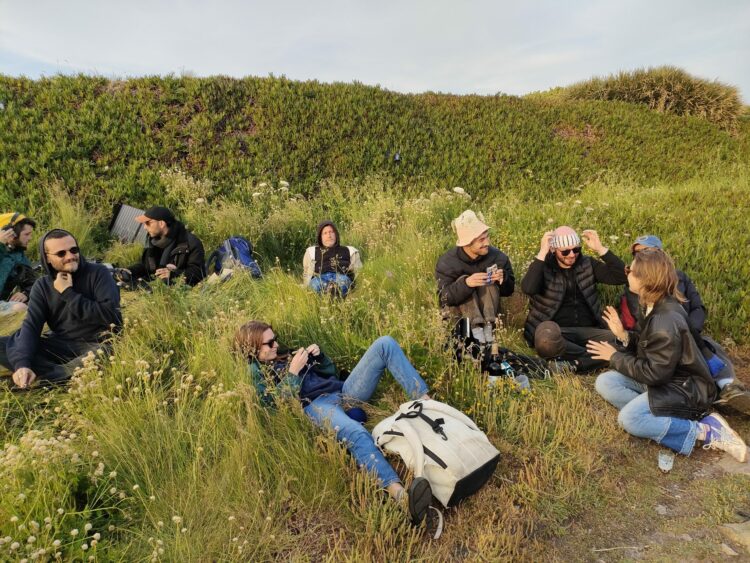
Pastoral pause. © Ewen Chardronnet
Who: Camille Bernicot, graphic designer in charge of Ultra’s communication and mediation; Ninon, master student in fine arts in Brest; Mathieu, 2nd-year student in arts and digital design; Clara, master in sound design in Talm-Le Mans; Solen, doing graphic design as civil service for Ultra and master student in design and social science in Rennes.
What: A sensitive map with floral inks made from flowers found on the island.
How: First, they had to find the flowers. Accompanied by Edouard Bal, Camille Bernicot and her team set off to encounter the island flora. “We took plants that were abundant for minimal impact,” Camille reports. “Valerian and brambles are invasive: bird’s-foot trefoil is one of the first plants that we noticed growing everywhere on the rocks.” The picked flowers were placed in hot water and left to infuse overnight. There are several possible ways to extract the colors: “Either we thicken the color with corn starch, or we create an effervescence to extract the pigment from the juice by adding alum salt and Blanc de Meudon.”
Once the process is complete, the colors appear in the form of powders that can be preserved for a long time. All that’s left is to select the desired pigments: “The colors need to be abundant enough to be reproduced in large quantities, and they need to go well together when superposed.” Poppy, bird’s-foot trefoil and brambles were selected.
Why: The sensitive map doesn’t aim to be geographically accurate, but rather to represent personal feelings about the island. So the team asked the other participants to share with them their memories and anecdotes of Batz. All came away with their personalized map, silk-screened in floral ink.
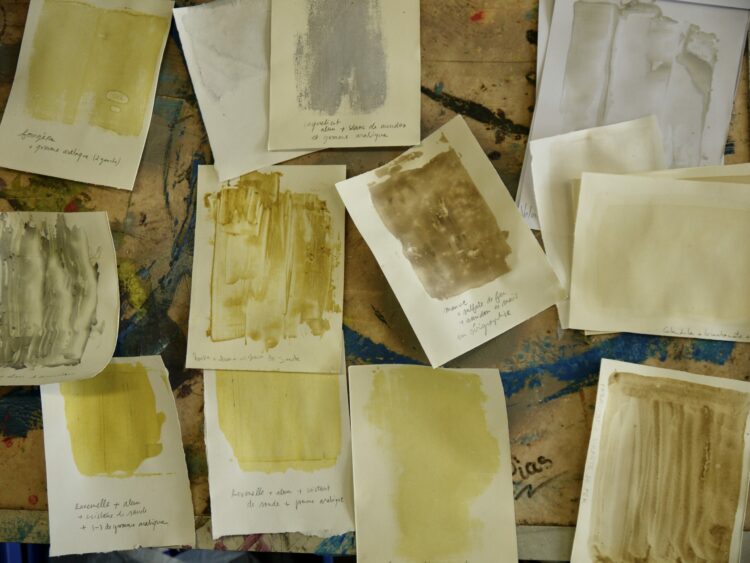
Floral ink tests. © Elsa Ferreira
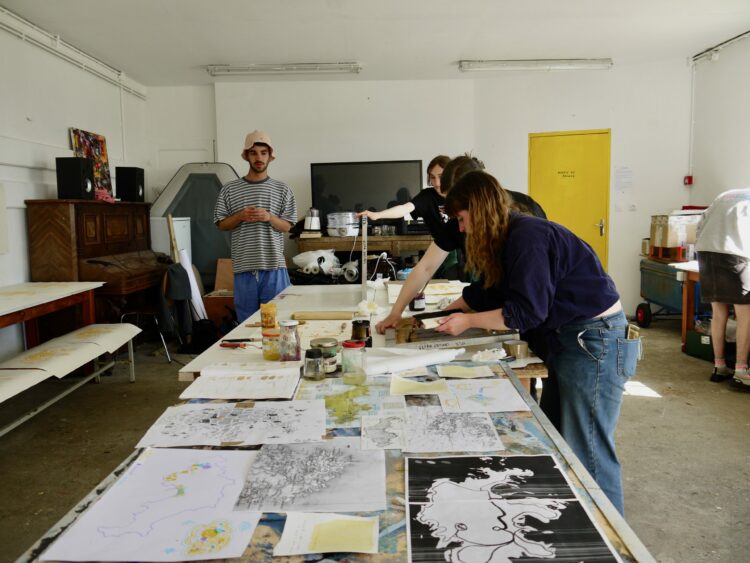
Work table for the sensitive map group. © Elsa Ferreira
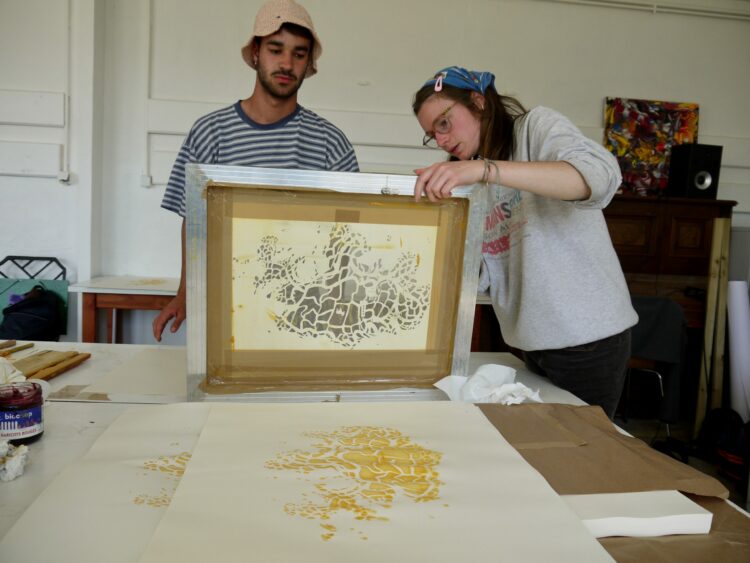
First layer for silk-screening the map. © Elsa Ferreira
Edible dishware for a local banquet
Who: Design Social Club, social and utopist designer; Charlie, designer and assistant for Ultra; Marion, design student in Rennes interning at Ultra; Blandine, graphic design student; Théo, in charge of documentation for Ultra as civil service.
What: Plant thermocompression to make biodegradable tableware.
How: Following a residency project started at Ultra one year ago, Design Social Club is continuing to explore the process of shaping plants by pressure and heat without adding binders. This group faced the challenge of finding raw materials on site. They collected algae that was abundant and in some cases already dry (the thermocompressor can’t press wet things), waste from the other workshops (especially the sensitive map, but also the post-production waste from other actors on the island). For example, the local brewery gave them a large quantity of dregs left over from the grains after brewing the beer.
The team also made a dryer using reclaimed materials found at the island garbage dump. The process will be shared in open source on Flat Shape, Ultra’s design-sharing platform.
Why: As a social and ecological reinterpretation of paper plates, bio-ceramics have been used to serve food prepared by the kitchen workshop during public presentations. Eventually, and with supplementary research, these biomaterials could have other uses, such as making signs for eco-construction.

Plant thermocompression by Design Social Club. © Elsa Ferreira

Edible plates. © Elsa Ferreira
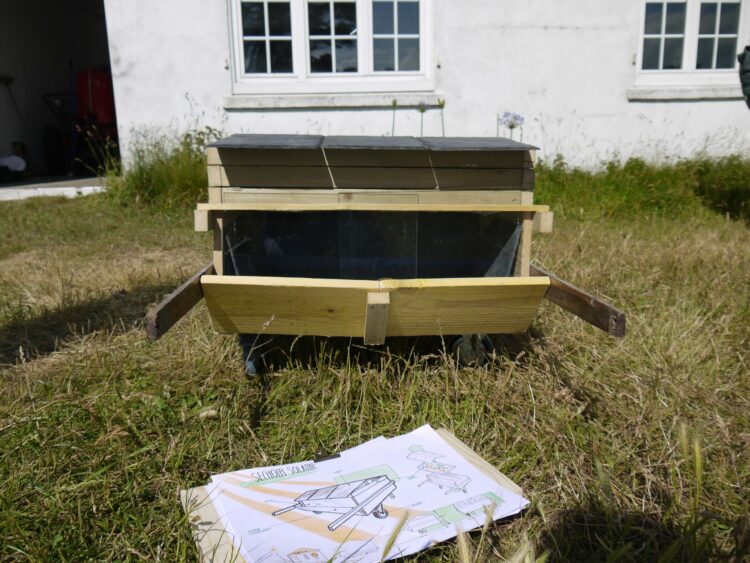
Low-tech solar dryer. © Elsa Ferreira
Who: P-node, a collective formed a decade ago, including streaming artists, technicians, musicians, hackers and “a whole list of people who are interested in questioning the radio medium”. P-node is also an associative radio channel. Introducing themselves as a group, individual members prefer to remain anonymous.
What: Radio art. “Usually, electromagnetic waves are used to transmit information between two distant points – it’s what we call telecommunication,” says P-node. With this kind of project, we’re interested in the physicality of the wave, and how to work on its poetic essence instead of using it just to transmit information.”
How: The collective makes what it calls “electromagnetic sculptures”, artworks that integrate visual and sound as well as electromagnetic aspects. In one of these installations, the members channel three phenomena present on the island: wind, water and sea radios. They begin by attaching an antenna to a very stable kite. “We create a point of infrastructure in the air that allows us to lift elements at more than 50 meters above ground. So we are at the highest point on the island,” they explain. The antenna captures the marine communications of boats passing through Ouessant, a hundred kilometers away. They attach a microphone to the rope, which captures the vibrations of the wind. They place hydrophones in the water as the tide rises. Using a small emitter attached to the kite, they retransmit all these elements live to portable radios all around the beach.
The result is a meditative soundtrack of the wind and the sea, mixed with human voices controlling boats and reading maritime weather forecasts. “We catch things in the air that are part of our environment,” they explain. “We have the tool to capture all this information that is constantly passing above our heads.” In addition to this poetic sculpture, P-node installs radio platforms hosting an “orchestra of speakers”. In this way, “the soundscape becomes a space for life, exchange, listening or napping.”
Why: These artworks are ephemeral and essentially linked to the landscape in which they come to life. They also like “the lightness and delicateness of catching things sparingly”. But there is some talk about preserving the sound piece captured by the kite. To be continued.
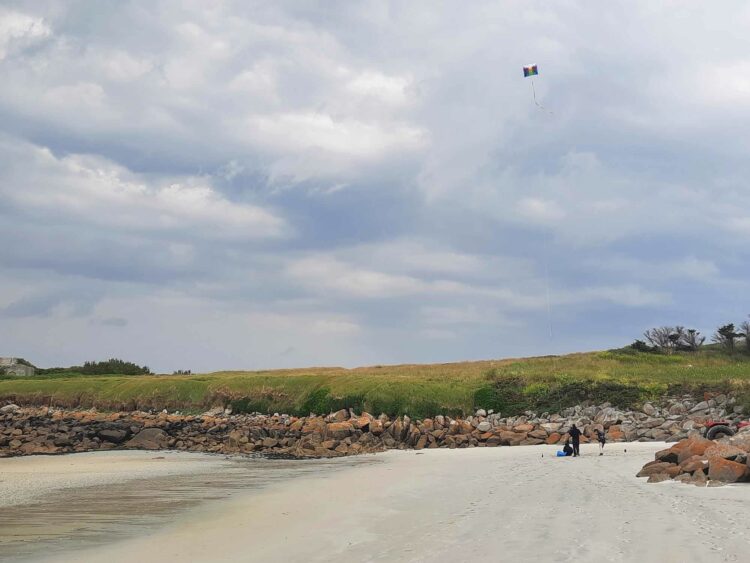
In the hands of P-node, the kite becomes a base to emit and receive. © Elsa Ferreira
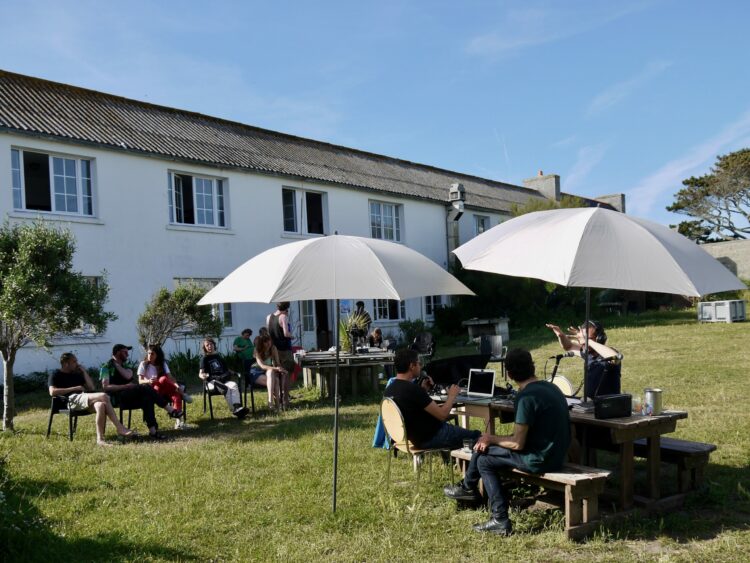
A radio platform and its listeners. © Elsa Ferreira
Cooking as a political metaphor
Who: Joanna Wong, visual artist and cofounder of the Enoki collective who uses cooking as a medium to talk about migration; Lola, master student in Brest; Arbol, a Columbian student of fine arts in Caen; Camille, 2nd-year student at HEAR arts school in Strasbourg.
What: A cooking experiment to valorize the ingredients of the island while reflecting each person’s culinary heritage and roots.
How: As an artist who is particularly adept at culinary installations, Joanna Wong explores the political implications of cooking. According to this Hong Kong citizen based in Paris: “Our umami, our taste palate, our culinary heritage depends on where and how we grew up, on our education, our personal background and with whom we have cooked. Give an egg and a mushroom to ten different people, you will get ten different recipes. Each time we cook, we express our background.”
As a migrant, Joanna wonders how we can recreate our culinary heritage. On the island of Batz, she puts this thought into action. By picking up food items on site, she notices similarities between the local cuisine on this island in Britanny and the cuisine of her native Hong Kong island. Algae reminds her of snack nori, very popular in Hong Kong, and buckwheat recalls soba noodles. The experiment is practical, as the workshop participants prepared meals for everyone at Artlabo Retreat.
For the general public, the team gave a workshop on cooking ravioli using local ingredients: potatos and radishes grown on the island and pink onions from Roscoff. The food item is quick to question the root and the cultural heritage of food itself, posits Joanna: “If you find all the ingredients in Italy, is it still a Chinese ravioli? What if the person cooking is Italian? What if it’s an Italian ravioli cooked by a Chinese person?”
Why: For Joanna, every gesture in cooking is a gesture of adaptation. It’s also a way for people to gather around a table to talk about sometimes complicated issues: “When I organize cooking installations, I don’t say ‘Come see an art performance’, I say “Come eat’.” A mouth-watering proposition indeed.
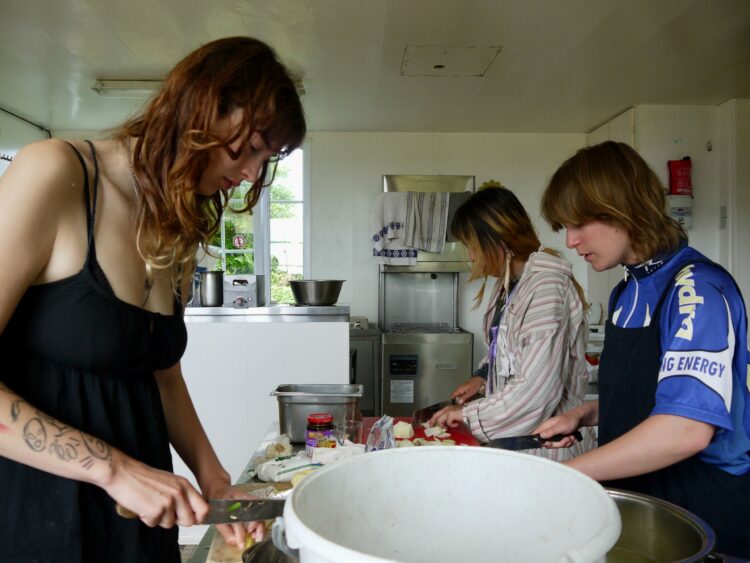
Ravioli cooking session. © Elsa Ferreira
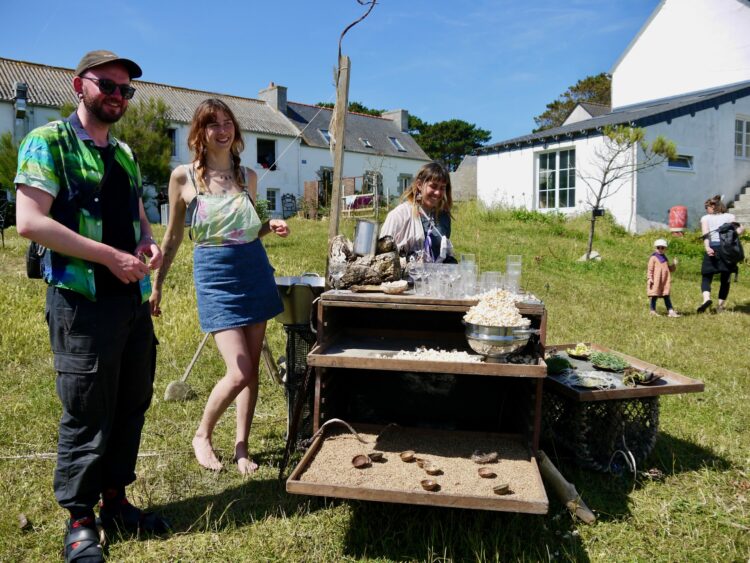
Kefir, popcorn and edible plates for open house days. © Elsa Ferreira
Homo Photosyntheticus, fieldwork
Who: Ewen Chardronnet, artist and editor-in-chief of Makery; Julie Verin, artist and designer; Arthur Barbe, multimedia artist; Léonore Bonaccini and Xavier Fourt of the duo Bureau d’études.
What: Research on algae in all its potential in light of the transition to sustainable energy and food sources – edible algae, algae pollution, medicinal uses, space research, biofuels, CO2 capture, biomaterials…
How: In this long-term project initiated in 2021, the collective of artists is building a knowledge base for documentation, especially video documentation. They are interviewing experts in what will become an interactive matrix, where the viewer can select the desired theme of exploration. On the island, the team took their video cameras back into the field along walks with the ethnobotanist Edouard Bal. Julie Verin explored methods of algae conservation, filming her experiments with a microscope camera. The collective also sets aside times for discussing various forms for the publications and reconstitutions.
The Algae of Batz Island, by Edouard Bal. Realized and edited by Quentin Aurat:
Why: Homo Photosyntheticus has already presented some of these works, including a dinner-installation around algae by Maya Minder. The collective is building partnerships and presenting its protean creations within art structures such as Antre-Peaux, project partner, or Jeu de Paume. In the long-term, a documentary film is also in production. “We’re trying to present stuff regularly in order to animate and enrich the project,” says Ewen Chardronnet.
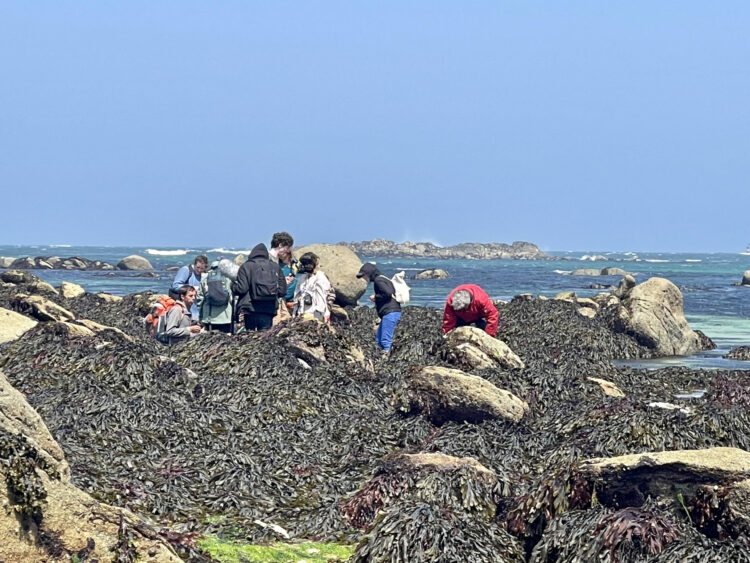
Walking among the algae. © Carine Le Malet

Reading table. © Elsa Ferreira
The ArtLabo Retreat is a bi-annual week-long international gathering. It takes place at the Island of Batz, off the Roscoff coast (Bretagne, FR). Its focus is on sharing research-creation practices in the field of marine biology, biomaterials, sustainable food, upcycling & circular economy, open source technology, video & sound arts and media publication.
In 2023, The ArtLabo Retreat is organised by ART2M/Makery in partnership with Association Ultra (Le Relecq-Kerhuon) and will invite national and international guests to mentor workshops with a strong focus on: bioart practices related to biology of evolution and marine biology; global algal photosynthesis and solar energy systemics; edible algae ethno-botany, algae foraging & cooking; circular economy, sustainable design, upcycling and biomaterials; hypermedia practices related to those fields.
ArtLabo Retreats are part of the Feral Labs Network and co-funded by the European Union – Feral Labs (2019-2021) & Rewilding Cultures (2022-2026)
The Rewilding Cultures (RC) project wants to reposition the wild after COVID and focus on inclusivity and ecology within the art, science and technology area. A new gaze at this sector is needed and the stop in everything caused by COVID, provides us with an uncomfortable, but much needed time for reflection on potential change. We cannot go back to business as usual, especially in terms of polluting and important inclusion issues unaddressed. We need to rewild on terms fit for the present and future.
Within the last 10 years we have witnessed a large growth of various Creative Hubs; Maker-, Bio-, Art-, Coworking- Labs and -Spaces. They come in many shapes and sizes and operate as initiatives that give participants a social space equipped with technological opportunities, a space where everyone is encouraged to experiment, explore, create and share. The importance of the social and the communal aspect is one of the most important aspects of these Creative Hubs; they are not only places of rapid prototyping and caters to artists’ and makers’ needs, they are so much more than the fabrication machines and tools and their operators. They are places of rich social life and homes of diverse communities. Creative Hubs are now indispensable facilitators of Open and Citizen science and localization of production, New business model, testers and developers of Future technologies, as well as places of new and innovative uses of old technologies. They are places of reinvention and innovation in educational, life-long-learning processes.
https://rewildingcultures.net/
for more infos: contact@makery.info
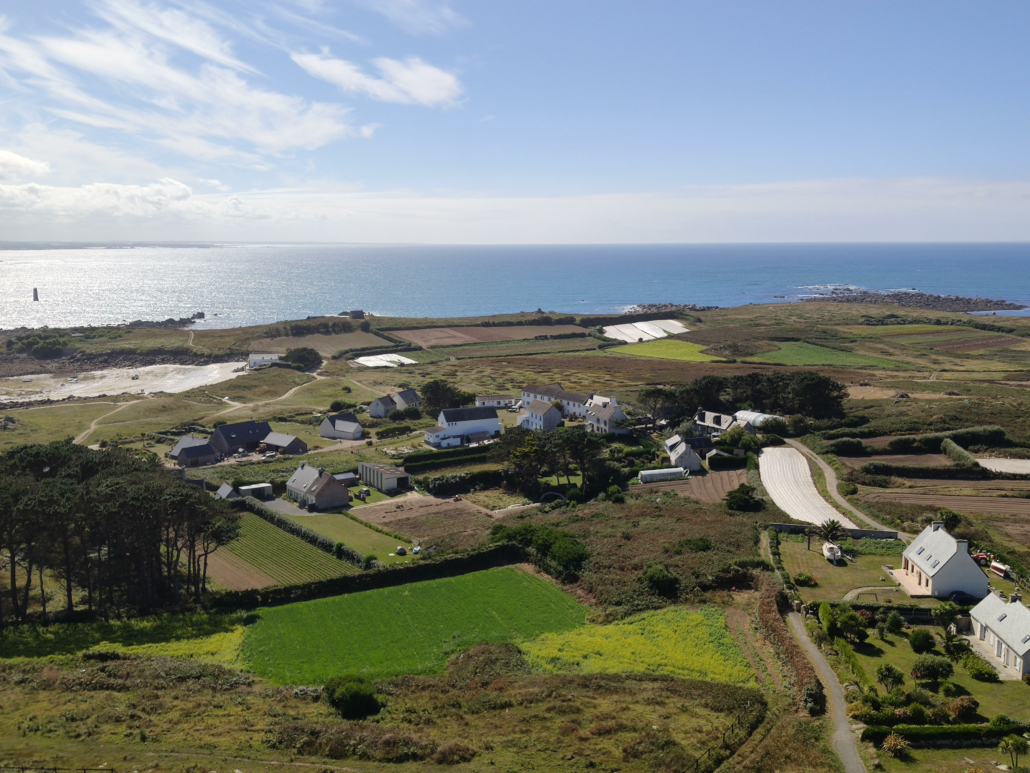
SUPPORTED BY

by Roland Fischer
(first published in Makery on September 20, 2020)
From August 16 to 24 2020, the first “ArtLabo Retreat” took place on the Island of Batz in France. The event was an encounter with the ArtLabo network, part of the Feral Labs network series launched in 2019. Roland Fischer from Symbiont.Space in Basel writes about his experience.
The periphery is the new center. And vice versa. Paris was almost empty in mid-August, but I was just passing through. Three hours west of the capital, the train was was practically full. Rain welcomed me in Morlaix, and another half-hour later I was sitting on a cafe terrace in Roscoff, on the northern coast of Brittany. The air was salty, the rain had stopped; the weather is fickle here. Final destination: Batz Island. Tidal range: maximal. Temperature range: minimal.
This geographical exception would be the perfect location for a week of exchanging with folks from all around Europe working on art-science projects—at least that was the plan before the Coronavirus struck us with its particular understanding of symbiosis. It turned out that Brittany was somewhat of a safe haven, as its number of Covid cases was among the lowest in Europe. Many people who had intended to come from abroad decided to stay at home nonetheless, given all the travel restrictions. The French, however, flocked to the island—Brittany’s remote coastline had never seen such a busy holiday season.
Distinguishing themselves from the flurry of tourists who were more interested in hiking and sunbathing, some 20-30 individuals gathered on Batz Island for a weeklong communion of experiments and discussions. As part of its activities within the European Feral Labs Network, Makery organized its first summer camp there: ArtLabo Retreat. Conceived as a meeting between the European Feral Labs network and the French ArtLabo network, the retreat provided an opportunity to share research and creative practices in Art/Society/Technologies.
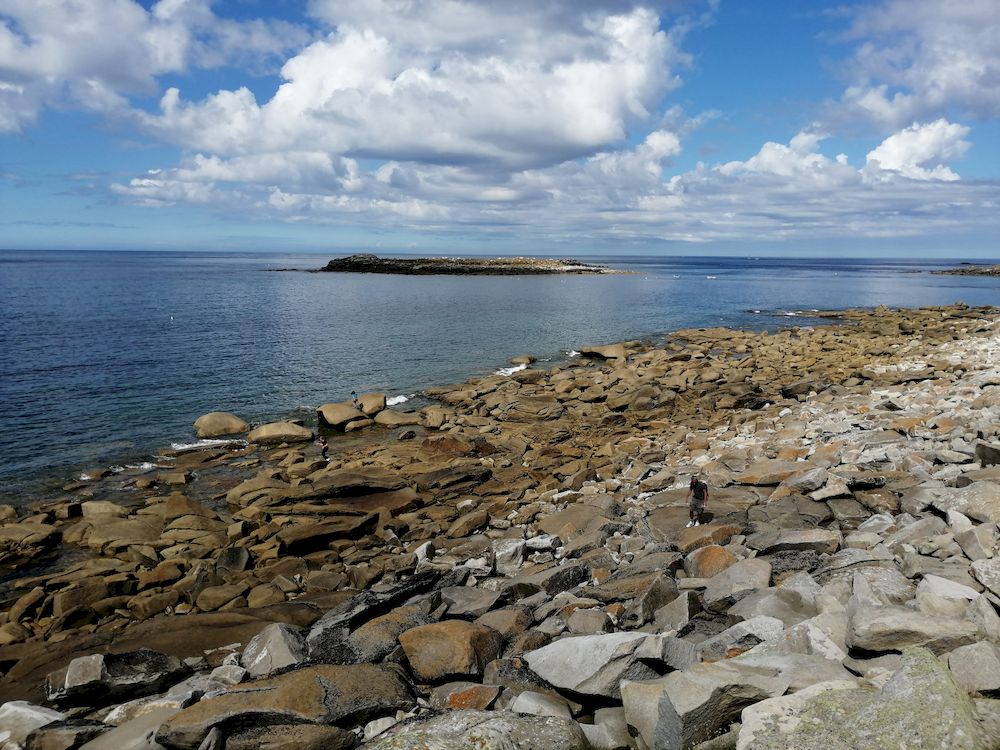
The theme of the retreat was “symbiosis”, in very broad terms: long-term partnerships between organisms, merging different skills or abilities in order to “upgrade” the system as a whole. Of course, this relationship holds true for many art projects as well, especially at the intersection of art, technology and science.
So it was quite fitting to kick off the event with a screening of the documentary film Symbiotic Earth about the evolutionary biologist Lynn Margulis. An eminent figure of modern biology, Margulis was often ridiculed at the beginning of her career. Her audacious idea was that evolution is not a continuous process, sometimes it happens in leaps and bounds. Abilities evolve within independent lifeforms, and something totally new and much more interesting emerges when two of these “prototypes” merge. She called it “symbiogenesis”. Instead of the mechanistic view that life evolved through random genetic mutations and competition, Margulis presented a symbiotic narrative in which bacteria joined together to create the complex cells that formed animals, plants and all other organisms—which together form a multi-dimensional living entity that covers the Earth. This also implies that humans are hardly the pinnacle of life itself, with the right to exploit nature, but simply one part of this complex cognitive system. As Margulis says in the film: “Bacteria have been here for billions of years, long before we arrived. They rule the world.” We could add, with the current headlines in mind, that viruses are certainly part of that old empire too. They might even be the discrete kings of symbiosis, but that’s a different story.
The screening was followed by a discussion led by Xavier Bailly, researcher of the Multicellular Marine Models laboratory of the Roscoff Biological Station and an expert on the local symbiotic hero: Symsagittifera roscoffensis, a marine worm that ingests algae to use them as energy supply—a truly exceptional “animal-plant” of the Brittany coastline. His presentation sparked a debate about symbiosis vs. parasitism. Who is exploiting whom in this merger of animal and algae? Is symbiosis always beneficial for both partners? And surprise—according to Wikipedia, we’ve been wrong about symbiosis all along: Symbiosis (from Greek συμβίωσις, sumbíōsis, “living together”, from σύν, sún, “together”, and βίωσις, bíōsis, “living”) is any type of close and long-term biological interaction between two different biological organisms, be it mutualistic, commensalistic, or parasitic.
So, even parasites can be symbionts? Nature doesn’t seem to insist on consensual relationships. Xavier Bailly showed recent close-ups from his lab exposing the algae in very “unnatural” forms. It looks almost as if they were constantly trying to flee their new habitat inside the worm’s body. So what about the arts? What are the power structures when it comes to art and science collaborations? Who is embracing whom here? Still much too often, these kinds of projects are shaped by hidden hierarchies—just follow the money. Scientists tend to exploit the arts according to their needs: popularization, illustration, creativity (a.k.a “thinking outside of the box”). In these contexts, the metaphors of mutual vs. parasitic can be used to reflect on structural and political framings of artistic collaborations, whereas Margulis herself warned about the dangers of using anthropomorphic concepts when describing or analyzing biological phenomena.
The Roscosmoe project, hosted by Ewen Chardronnet, takes the Symsagittifera roscoffensis story one small step (or one giant leap?) further, into space. The project narrates the journey of S. roscoffensis through the stages of its selection as a “cosmonaut candidate” in view of its possible departure for extraterrestrial space. Should we see the “animal-plant” as the perfect space explorer, living solely on the energy of the sun?
Speaking of solar energy, the Energylab, hosted by Cédric Carles and Loïc Rogard from Atelier21, presented fantastic innovations from the history of energy: pioneering devices that were not considered relevant or reliable in their time, did not find interested users or lacked a technical brick to make the system efficient. As they say: “Inhale the past, Exhale the future, Fly with the sun”. A recent descendant of the solar flight pioneers was present on the island as well. Weather permitting, sometime over the course of the week they had planned to fly the solar balloon Aerocene Backpack from Aerocene Community France, hoping to send a GoPro camera high up in the air. But as mentioned previously, the weather is fickle: after a moment of sun there were too many clouds, so instead of a research device, the balloon ended up being a huge and surreal black toy for the children on the beach. But that worked just as beautifully.
Meanwhile, Joachim Montessuis invited everyone into a think-tank, an ephemeral discussion-debate group about art and consciousness, based on his course on sound and spirituality at Ecole Supérieure des Arts Décoratifs in Strasbourg. Is the artist’s subjective ego (or even collective ego) still a sufficient notion nowadays? Can we go beyond the existentialist binarity of the ego of the artist who is master of his reality and his destiny, in order to gain a deeper experience? Who creates, for whom, and for what benefit? Back to the debate around symbiosis and parasitism.
Channeling a more substantial kind of spirit, I decided to expand my experiments in sonic maturing to local applejack liquors, injecting them with high doses of ultrasonic energy. Is this physical chemistry or succussion quackery, as practiced by homeopaths? What happens to strong alcohols when they are stimulated with ultrasonic waves? When they are basically shaken very hard, from the inside out? There is a tradition: “The color and flavor of Kentucky bourbon came from the rocking on the water. Bourbon was loaded on to ships in Kentucky, and by the time it traveled to the people buying it, the flavor improved.”
The Margulis documentary found a surprising echo two days later in Spaceship Earth, a film about the most unlikely partnership of late capitalism: Biosphere 2 and Steve Bannon. Pity both films were terribly conventional, artistically speaking: first-person narrations, talking heads. In contrast, some of the presented projects offered somewhat different and more rhizomic experiments in cultural-technological practices.om the rocking on the water. Bourbon was loaded on to ships in Kentucky, and by the time it traveled to the people buying it, the flavor improved.”
A few members of MyOwnDocumenta (Corisande Bonnin, Charlotte Imbault, Dominique Petitgand) also joined the retreat. MyOwnDocumenta (artists publishing works-in-progress and diaries hosted by David Guez) is a group that believes that the process is probably more important than the final result, which was certainly the case in discussions of the ArtLabo network led by Julien Bellanger and Catherine Lenoble. Their workshop was held all week long in the studio of the colony, a beautifully strange space full of toys, painting accessories, holiday leftovers. There the hosts invited all participants to discuss and test tools and practices related to documenting and sharing our experiences towards more digital autonomy. Along the way, the colony became an ephemeral radio station, broadcasting on Pi-node. It sent out signals in the dark, just like the lighthouse on the hill above the colony, as its beam continued to rotate, blinking out its message to the black seas. But wait, is there a signal even when there is no one to see it?
Since 2015, Makery has been a member of the network ArtLabo. The ArtLabo Retreat 2020 is a meeting between the European network Feral Labs and the French network ArtLabo, two networks sharing research-creation practices Art/Society/Technologies.
Due to Covid-19, the ArtLabo Retreat has however had to reduce its staff and give up a call for projects.
Feral Labs network
A network of temporary and offshore hubs for research in art, technology and communities, the Feral Labs Network, is composed of six partners from six EU countries, who have come together in their common interest in arts and science research and contemporary Do-It-Yourself (DIY) and Do-It-With-Others (DIWO) communities. Rather than focusing on modes of presentation such as exhibitions and festivals, the Feral Labs network focuses on connecting and organizing a series of similarly formatted temporary creative camps and environments, with an emphasis on process-based activities such as peer learning, fieldwork, research and co-creation. What these activities have in common is their deliberate placement in a remote environment, far from the usual urban setting of contemporary creative centers.
Over the past two years, the project partners have been creating a variety of temporary creative poles that vary in scope, format and topics covered, but all have a common methodological starting point: temporary, international, remote, open and transdisciplinary (art-technology-science).
The Feral Labs network is initiated and coordinated by the Projekt Atol Institute (SI) in partnership with Makery/Digital Art International (FR), Catch/Helsingør Kommune (DK), SCHMIEDE HALLEIN – Verein zur Förderung der digitalen Kultur (AT), Bioart Society (FI) and Udruga za razvoj uradi sam kulture Radiona (HR).
Network ArtLabo
Since its informal creation around 2004, ArtLabo is animated by structures such as the Labomedia (Orléans), PIB (Tours), the Lieu multiple (Poitiers), Bandits-Mages (Bourges) and the association PiNG (Nantes) but above all many people involved in common research-action territories. ArtLabo has been organizing meetings for many years, 0camp in Nantes in 2015, 1camp in 2016, or during the Human Tech Days / Rencontres Arts & Sciences Friction in Bourges in January 2020. The principle: based on a common axis of work, the partner structures, as well as a large network of speakers, test during a given period the collective exploration of a subject around a program, debates or a coordinated series of common actions.
ArtLabo
Hosted by Julien Bellanger and Catherine Lenoble
Behind the philosophy of collaborative projects and informal exchanges, the ArtLabo Retreat 2020 workshop will be an opportunity to discuss and test tools and practices related to documenting and recounting our experiences towards more digital autonomy (Radio, pad writing with CodimD, system autonomous or not, etc.).
Roscosmoe
Hosted by Ewen Chardronnet
The objective of the Roscosmoe project is to narrate the journey of the Symsagittifera roscoffensis, a symbiotic marine worm, an exceptional “animal-plant” of the Breton coastline, in the stages of its selection as a “cosmonaut candidate” in view of its possible departure for extraterrestrial space. Roscosmoe is a speculative narrative exploring the endosymbiotic theory of evolution (Lynn Margulis), our multi-species nature, the fragility of marine symbioses and environments in the face of global warming, ocean acidification and anthropogenic influences, notions of spatial ecology and the study of living things and the evolution of life in the face of conditions of variable gravity. The Roscosmoe project aims to create an artistic installation that will take the form of a connected and self-sufficient bathyscaphe aquarium containing a colony of marine worms in seawater. This speculative prototype of a future research module for a space station will be surrounded by multimedia devices offering the vital and environmental data of the device in real time, a system of multicasting of the different stages of the selection of the “candidate-cosmonaut”. The objective of the workshop on the Island of Batz is to become familiar with the species Symsagittifera roscoffensis and to determine the scriptwriting processes of the speculative narrative around the Roscosmoe project.
Symbiotic Earth
Animated by Xavier Bailly and Ewen Chardronnet
Viewing of the documentary Symbiotic Earth on evolutionary biologist Lynn Margulis on two mornings on Tuesday 18 and Wednesday 19 August, followed by a discussion around the film on the 19th conducted by Xavier Bailly, researcher of the laboratory Multicellular Marine Models of the Roscoff Biological Station.
SYMBIOTIC EARTH explores the life and ideas of Lynn Margulis, a brilliant and radical scientist, whose unconventional theories challenged the male-dominated scientific community and are today fundamentally changing how we look at our selves, evolution, and the environment.
As a young scientist in the 1960s, Margulis was ridiculed when she first proposed that symbiosis was a key driver of evolution, but she persisted. Instead of the mechanistic view that life evolved through random genetic mutations and competition, she presented a symbiotic narrative in which bacteria joined together to create the complex cells that formed animals, plants and all other organisms – which together form a multi-dimensional living entity that covers the Earth. Humans are not the pinnacle of life with the right to exploit nature, but part of this complex cognitive system in which each of our actions has repercussions.
Filmmaker John Feldman traveled globally to meet Margulis’ cutting-edge colleagues and continually asked: What happens when the truth changes? SYMBIOTIC EARTH examines the worldview that has led to climate change and extreme capitalism and offers a new approach to understanding life that encourages a sustainable and symbiotic lifestyle.
ATELIER21 ENERGYLAB: “Inhale the past, Exhale the future, Fly with the sun”
Animated by Cédric Carles and Loïc Rogard
The history of energy is full of fantastic innovations, precursor devices that were not considered relevant or reliable in their time, did not find interested users or lacked a technical brick to make the system efficient. Yet these forgotten inventions are today in a position to respond favourably and probably unexpectedly to the challenges of the world to come. This new writing of the history of energy calls for an overall vision that allows us to move on to other fertile phases of analysis and creation. The methodology of the platform paleo-energetique.org therefore proposes to explore the public domain, retrotech and lowtech in order to unearth unjustly forgotten innovations. “Inhale the past, Exhale the future”: the Arte Labo Retreat will be the occasion of a retrospective around the foundation Aerocene, to gather a collective iconography and to reconstruct a history of flights and machines to fly, each one crazier than the other, including those using bicycles or solar energy. “Fly with the sun”, depending on the weather, we will be able to organize flights with the solar balloon Aerocene Backpack from Aerocene Community France, it will be possible to take pictures with go pro, to test the maximum weight that can be lifted by the balloon, etc.).
The website of Atelier21.
Experiments with sonic maturation: treating drinks with high doses of ultrasonic energy.
Hosted by Roland Fischer
Is it physical chemistry or is it succussion quackery? What happens to strong alcohols when they are stimulated with ultrasonic waves? When they are basically shaken very hard, from the inside out?
“The color and flavor of Kentucky bourbon came from the rocking on the water. Bourbon was loaded on to ships in Kentucky, and by the time it traveled to the people buying it, the flavor improved.”
THINK TANK, ephemeral discussion-debate group around :
Art and consciousness (non-duality and non-binary thoughts)
Hosted by Joachim Montessuis
From the Vedas (knowledge) to the Latin Scientia (knowledge), up to Artificial Intelligence through quantum, we are led to experiment our relationship to reality either with a classic dualistic and objective approach, or with a more subtle, very old and very current approach: the non-distinction between consciousness and matter. This approach completely redefines our relationship to reality, to the social, political and therefore artistic space. But what are really the differences between dualism and non-dualism?
Is the artist’s subjective ego (or even collective ego) still a sufficient notion nowadays? Can we go beyond the existentialist binarity of the ego of the artist who is master of his reality and his destiny, in order to have a deeper experience? Who creates, for whom, and to what benefit? Is non-dual awakening the last vanguard in a mutant world?
The participants and residents of the ArtLabo Retreat:
Xavier Bailly (Laboratoire M3, Station Biologique de Roscoff, Fr)
Charlotte Bartissol (Atelier21, Fr)
Julien Bellanger (Ping, Fr)
Corisande Bonnin (Fr)
Cédric Carles (Atelier21, Fr)
Ewen Chardronnet (Makery, Fr)
Shu Lea Cheang (Tw/US/Fr)
Florence Cherrier (ArtLab – Mains d’œuvres & La Station, Fr)
Julie Corre (Fr)
Eric Daviron (Collectif Mu & La Station, Fr)
Roland Fischer (Symbiont.space, Ch)
Clément Gasque (GDP, Fr)
David Guez (MyOwnDocumenta, fr)
Agathe Herry (Fr)
Charlotte Imbault (Fr)
Wolf Kuehr (Volumes, De/Fr)
Olivier Le Gal (Collectif Mu & La Station, Fr)
Catherine Lenoble (PIB, Fr)
Alice Marsal (Fr)
Anne Métrard (Fr)
Joachim Montessuis (Fr)
Florence Morat (Fr)
Olivier Morvan (Fr)
Dominique Petigand (Fr)
François Robin (Makery, Fr)
Loïc Rogard (Atelier21, Fr)
Gaël Segalen (Fr)
Lionel Sayag (Fr)
Marc Swyngedauw (Fr)
Anaïs Tondeur (Watermarks, Fr)
Miha Turšič (Waag, Si/Nl)
SUPPORTED BY



